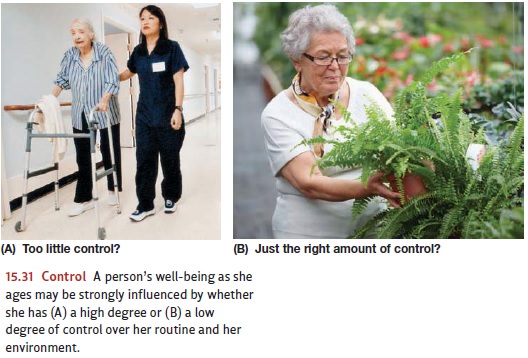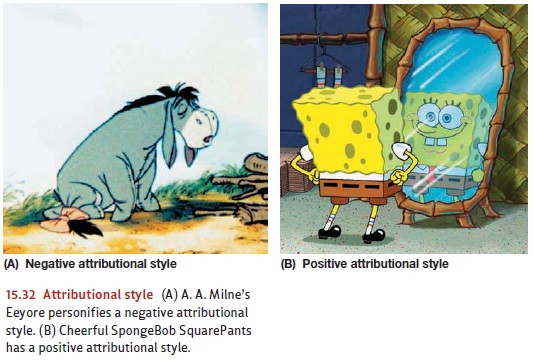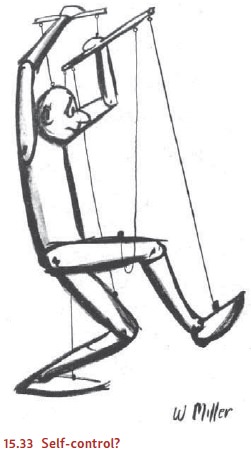Chapter: Psychology: Personality
Key Social-Cognitive Concepts
Key Social-Cognitive Concepts
Social-cognitive
theorists differ in focus and emphasis, but across theorists, three con-cepts
play a crucial role. These are control,
attributional style (which refers to
how we typically explain the things that happen in our lives), and self-control. We take up each of these
in turn.
CONTROL
There
is a great deal of evidence that people desire control over the circumstances
of their life and benefit from feeling that they have such control.
A
widely cited illustration involves elderly people in a nursing home. Patients
on one floor of the nursing home were given small houseplants to care for, and
they were also asked to choose the time at which they wanted to participate in
some of the nursing-home activities (e.g., visiting friends, watching
television, planning social events). Patients on another floor were also given
plants but with the understanding that the plants would be tended by the staff.
They participated in the same activities as the first group of patients, but at
times chosen by the staff. The results were clear-cut. According to both
nurses’ and the patients’ own reports, the patients who tended their own
houseplants and scheduled their own activities were more active and felt better
than the patients who lacked this con-trol, a difference that was still
apparent a year later (Langer & Rodin, 1976; Rodin & Langer, 1977;
Figure 15.31).

Having
control means being able to make choices, and so, if having control is a good
thing, then having choices would seem to be a good thing too, and the more the
better. This line of reasoning is certainly consistent with the way various
goods and services are marketed—with both retail stores and large corporations
offering us dozens of options whenever we order a latte, buy a new cell phone,
select an insurance plan, or go on a vaca-tion. However, in a series of
studies, Sheena Iyengar and Mark Lepper (2000) found that there is such a thing
as too much choice. One of these studies was conducted in a gour-met food
store, where the researchers created displays featuring fancy jams that
customers could taste. Some displays had 6 kinds of jam to taste. Other
displays had 24 kinds of jam to taste. Although people flocked to the larger
display, it turned out that people were actually 10 times as likely to purchase
a jam they had tasted if they had seen the smaller display as compared to the
larger display. Reviewing this and related studies, Barry Schwartz (2004)
concluded that although having some choice (and hence con-trol) is extremely
important, having too much choice leads to greater stress and anxiety rather
than greater pleasure. These findings indicate there can be too much of an
appar-ently good thing, and suggest that other considerations (such as managing
the anxiety occasioned by having too many choices) may under some circumstances
lead us to prefer lesser rather than greater control (see also Shah &
Wolford, 2007).
ATTRIBUTIONALSTYLE
Control
beliefs are usually forward looking: Which jam will I buy? When will I visit my
friends? A different category of beliefs, in contrast, is oriented toward the
past and—more specifically—concerns people’s explanations for the events they
have experienced.
In
general, people tend to offer dispositional attributions for their own
successes (“I did well on the test because I’m smart”), but situational
attributions for their fail-ures (“My company is losing money because of the
downturn in the economy”; “I lost the match because the sun was in my eyes”).
This pattern is obviously self-serving, and has been documented in many Western
cultures (Bradley, 1978). In most studies, par-ticipants perform various
tasks—ranging from alleged measures of motor skills to tests of social
sensitivity—and then receive fake feedback on whether they had achieved some
criterion of success (see, for example, Luginbuhl, Crowe, & Kahan, 1975; D.
T. Miller, 1976; Sicoly & Ross, 1977; M. L. Snyder, Stephan, & Rosenfield,
1976; Stevens & Jones, 1976). The overall pattern of results is always the
same: By and large, the participants attribute their successes to internal
factors (they were pretty good at such tasks, and they worked hard) and their
failures to external factors (the task was too difficult, and they were
unlucky).
The
same pattern is evident outside the laboratory. One study analyzed the
com-ments of football and baseball players following important games, as
published in newspapers. Of the statements made by the winners, 80% were
internal attributions: “Our team was great,” “Our star player did it all,” and
so on. In contrast, only 53% of the losers gave internal attributions, and they
often explained the outcomes by referring to external, situational factors: “I
think we hit the ball all right. But I think we’re unlucky”.
These
attributions are offered, of course, after an event—after the team has won or
lost, or after the business has succeeded or failed. But a related pattern
arises before an event, allowing
people to protect themselves against failure and disappoint-ment. One such
strategy is known as self-handicapping,
in which one arranges an obstacle to one’s own performance. This way, if
failure occurs, it will be attributed to the obstacle and not to one’s own limitations
(Higgins, Snyder, & Berglas, 1990; Jones & Berglas, 1978). Thus, if
Julie is afraid of failing next week’s biology exam, she might spend more time
than usual watching television. Then, if she fails the exam, the obvious
interpretation will be that she did not study hard enough, rather than that she
is stupid.
Not
surprisingly, all these forms of self-protection are less likely in
collectivistic cultures—that is, among people who are not motivated to view
themselves as differ-ent from and better than others. But there is some
subtlety to the cultural patterning. A recent analysis of the self-serving bias
found that the Japanese and Pacific Islanders showed no self-serving biases,
Indians displayed a moderate bias, and Chinese and Koreans showed large
self-serving biases. It is not clear why these differences arose, and
explaining this point is a fruitful area for future research. In the meantime,
though, this analysis reminds us of the important point that there is a great
deal of variation within collectivistic, interdependent cultures.
Even
within a given culture, there are notable differences in attributional style, the way a person typically explains the things
that happen in his or her life (Figure 15.32). This style can be measured by a
specially constructed attributional-style questionnaire (ASQ) in which a
participant is asked to imagine himself in a number of situations (e.g.,
failing a test) and to indicate what would have caused those events if they had
happened to him (Dykema, Bergbower, Doctora, & Peterson, 1996; C. Peterson
& Park, 1998; C. Peterson et al., 1982). His responses on the ASQ reveal
how he explains his failure. He may think he did not study enough (an internal
cause) or that the teacher

misled
him about what to study (an external cause). He may think he is generally
stu-pid (a global explanation) or is stupid on just that test material (a
specific explanation). Finally, he may believe he is always bound to fail (a
stable explanation) or that with a little extra studying he can recover nicely
(an unstable explanation).
Differences
in attributional style matter (Peterson & Park, 2007). More specifically,
greater use of external, specific, and unstable attributions for failure
predicts important outcomes ranging from performance in insurance sales
(Seligman & Schulman, 1986) to success in competitive sports (Seligman,
Nolen-Hoeksema, Thornton, & Thornton, 1990). Importantly, variation in
attributional style has also been shown to predict the onset of some forms of
psychopathology, such as whether a person is likely to suffer from depression .
Specifically, being prone to depression is correlated with a particular
attributional style—a tendency to attribute unfortunate events to causes that
are internal, global, and stable. Thus, a person who is prone to depression is
likely to attribute life events to causes related to something within her that
applies tomany other situations and will continue indefinitely (G. M. Buchanan &
Seligman, 1995; C. Peterson & Seligman, 1984; C. Peterson & Vaidya,
2001; Seligman & Gillham, 2000).
SELF - CONTROL
So
far we have emphasized each person’s control over his life circumstances, but
just as important for the social-cognitive theorists is the degree of control
each person has over himself and his own actions. Surely people differ in this
regard, and these differ-ences in self-control
are visible in various ways (Figure 15.33). People differ in their ability to
do what they know they should—whether the issue is being polite to an obnoxious
supervisor at work, or keeping focused despite the distraction of a talkative
roommate. They also differ in whether they can avoid doing what they want to do
but should not—for example, not joining friends for a movie the night before an
exam. People also differ from each other in their capacity to do things they
dislike in order to get what they want eventually—for example, studying extra
hard now in order to do well later in job or graduate school applications.

Examples
of self-control (and lack thereof ) abound in everyday life. Self-control is
manifested whenever we get out of bed in the morning, because we know we
should, even though we are still quite sleepy. It is also evident when we eat
an extra helping of dessert when we’re dieting (or don’t), or quit smoking (or
don’t). In each case, the abil-ity to control oneself is tied to what people
often call willpower, and, according
to popu-lar wisdom, some people have more willpower than others. But do they
really? That is, is “having a lot of willpower” a trait that is consistent over
time and across situations?
Walter
Mischel (1974, 1984) and his associates (Mischel, Shoda, & Rodriguez, 1992)
studied this issue in children. The participants in his studies were between
four and five years of age and were shown two snacks, one preferable to the
other (e.g., two marshmallows or pretzels versus one). To obtain the snack they
preferred, they had to wait about 15 minutes. If they did not want to wait, or
grew tired of waiting, they imme-diately received the less desirable treat but
had to forgo the more desirable one.
Whether
the children could manage the wait was powerfully influenced by what the
children did and thought about while they waited. If they looked at the
marsh-mallow, or worse, thought about eating it, they usually succumbed and
grabbed the lesser reward. But they were able to wait for the preferred snack
if they found (or were shown) some way of distracting their attention from it,
for example, by thinking of something fun, such as Mommy pushing them on a
swing. They could also wait for the preferred snack if they thought about the
snack in some way other than eating it, for example, by focusing on the
pretzels’ shape and color rather than on their crunchiness and taste. By
mentally transforming the desired object, the children managed to delay
gratification and thereby obtain the larger reward (Mischel, 1984; Mischel
& Baker, 1975; Mischel & Mischel, 1983; Mischel & Moore, 1980;
Rodriguez, Mischel, & Shoda, 1989).
These
various findings show that whether a child delays gratification depends in part
on how she construes the situation. But it apparently also depends on some
qual-ities of the child herself. The best evidence comes from follow-up studies
that show remarkable correlations between children’s ability to delay
gratification at age 4 (e.g., the ability to wait for the two pretzels) and
some of their personality characteristics a decade or more later (Figure
15.34). Being able to tolerate lengthy delays of gratification in early
childhood predicts both academic and social competence in adolescence (as rated
by the child’s parents) and general coping ability. When compared to the
children who could not delay gratification, those who could were judged (as
young teenagers) to be more articulate, attentive, self-reliant, able to plan
and think ahead, academically competent, and resilient under stress (Eigsti et
al., 2006; Mischel, Shoda, & Peake, 1988; Shoda, Mischel, & Peake,
1990).

Why should a 4-year-old’s ability to wait 15 minutes to get two pretzels rather than one predict such important qualities as academic and social competence 10 years later? The answer probably lies in the fact that the cognitive processes that underlie this deceptively simple task in childhood are the same ones needed for success in adoles-cence and adulthood. After all, success in school often requires that short-term goals (e.g., partying during the week) be subordinated to long-term purposes (e.g., getting good grades). The same holds for social relations, because someone who gives in to every momentary impulse will be hard-pressed to keep friends, sustain commitments, or participate in team sports. In both academic and social domains, reaching any long-term goal inevitably means renouncing lesser goals that beckon in the interim.
If
there is some general capacity for delaying gratification, useful for child and
adult alike, where does it originate? As we saw, intelligence has a heritable
component, and the executive control processes that support delaying
gratification also may have a heritable component. It seems likely, however,
that there is also a large learned component. Children may acquire certain
cognitive skills (e.g., self-distraction, reevaluating rewards, and sustaining
attention to distant goals) that they continue to apply and improve upon as
they get older. However they originate, though, these atten-tion-diverting
strategies appear to emerge in the first two years of life and can be seen in
the child’s attachment behavior with the mother. In one study, toddlers were
observed during a brief separation from their mothers, using a variant of the
Strange Situation task already discussed. Some of the toddlers showed immediate
distress, while others distracted themselves with other activities. Those who
engaged in self-distraction as toddlers were able to delay gratification longer
when they reached the age of 5 (Sethi, Mischel, Aber, Shoda, & Rodriguez,
2000).
But
what if one didn’t develop these valuable self-regulatory capacities and skills
by early childhood? Is one simply out of luck? Proponents of a social cognitive
perspective would argue not, pointing to studies in which self-regulatory
ability was enhanced by simple changes in how individuals construed the
situation in which they found themselves. In one study, for example, Magen and
Gross (2007) asked participants to solve simple math problems. What made this
task difficult was that a hilarious comedy routine was playing loudly on a
television just beside the monitor on which the math problems were being presented.
Participants were instructed to do their best, and they understood that they
could win a prize if they had a particularly good math score. Even though they
were motivated to do well, participants peeked at the television show even
though this hurt their performance on the test. Then, halfway through the math
test, one group of test-takers was simply reminded to do as well as they could
on the second half of the math test. The second group got the same reminder,
but in addition, they were told that they might find it helpful to think of the
math test as a test of their willpower. Because these participants highly
valued their willpower, this provided an extra incentive for them to stay
focused on their task. This simple reconstrual of the math test context as a
test of their willpower led them to peek less often during the sec-ond half of
the math test than did the participants in the other instructional group.
Related Topics